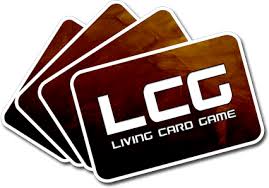Invasion of the Living Card Game!!!
In the world of card games there is one king, Magic the Gathering (MtG). The game has been around since 1993 and has been through it’s ups and down competing with other card games along the way. Pokemon, Yu-Gi-Oh and many others tried to enter the market and some did with success. However, the Collectible Card Game (CCG) model is currently being challenged by a new beast, the Living Card Game (LCG). This type of game, which sound like a B movie horror villain, is making some waves by capturing such franchises such as Lord of the Ring, A Game of Thrones, and Warhammer. What is the difference between an LCG and a CCG you ask? Well that is exactly what I will tell you in the edition of Game Corner. *queue cheesy music*
Let us start with a question: What is an LCG?
“Living Card Game and its acronym (LCG) are registered trademarks from Fantasy Flight Games. Fantasy Flight Games defines them as a variant of collectible card games” as written on the Fantasy Flight website. I will eventually stop talking about Fantasy Flight games, but they really do have a large part of he market currently. The term some use a lot for CCG’s is, “blind buy model.” If you have ever bought a booster pack of MtG, you have participated in this, “blind buy model.” This model is where you do not know what you are getting when you buy expansion material for the game. LCG’s do not participate in model. Every expansion for a LCG has 3 (the max number of cards permitted in a deck) of each card being printed in that expansion. This means everyone that buys the expansions has the same cards. Some of the most notable LCG’s are Android: Netrunner, Lord of the Rings: The Card Game, and the veteran, be going on 6 years, A Game of Thrones: The Card Game. These are all produced by Fantasy Flight games and, as of yet, no other company has either gotten the rights or decided to copy this model.
Now lets ask another questions: What is a CCG?
Briefly, a CCG follows a random booster model in order to induce a price market for cards. Hence the word collectible. The price of cards printed in CCG’s is usually directly related to their rarity. Common cards, which typically dilute booster packs, are opened any time someone buys a booster which at a rate of typically 15 a pack. However, a single increased rarity card is usually present, thus making it less likely to open multiples by simply opening multiple packs. This typically translates to a decreased supply of higher rarity cards, duh, and causes them to be more expensive than common cards, when combined with demand (See Garions Econ in gaming article coming out soon for more info on supply and demand). Some of the notable CCG’s are Magic: The Gathering, Yu-Gi-Oh, and Pokemon. Many different companies use this model to sell cards. Lets look at some of the more specific similarities and difference between a CCG and a LCG
What is the same?
Booster Packs: Each of the two models has booster packs. LCG’s get fancy with with the names Data pack for Android: Netrunner and Adventure Packs for LOTR:TCG, but they are the same in essence. A package of cards to update your game.
Deck Building Restrictions: Both of the models only let you put a select number of cards in your deck when you are building a deck. This means you only need a set number to always have enough to put in to any deck.
What is different?
Print Runs: LCG’s print all the cards you need in any given booster pack. they als0 print on demand which mean they continue to print it as long as people want to buy it. CCG’s have random booster packs, as we said before. The randomness of the booster is a type of control on expensive cards and it fixes the price. Controlling print runs of cards is a way for a CCG’s to control prices. Is a card to expensive? Then print more of it; but, happens when a card works to well? Funny you should ask that other person I am talking to, let us move to our next difference.
Ban Lists (a.k.a. Card Control): When a card in a CCG is becoming too powerful a ban list can be created in order to limit the number of cards in a deck or even remove it completely. As it stands now no LCG’s have ban lists.
Most companies choose the CCG model over the LCG model because of money reasons and because, I think, FFG still over the copyright of the LCG. So that is the end of the article …go buy some cards and try your hand at both models and let me know which one you like better. Also lemme know what I missed!



Pingback: Boxed Culture: Insanity is in the Cards |
Pingback: Boxed Culture: Expansion Madness!! – Aeither.net
Pingback: The Living Card Guy: Coping with Change – Aeither.net